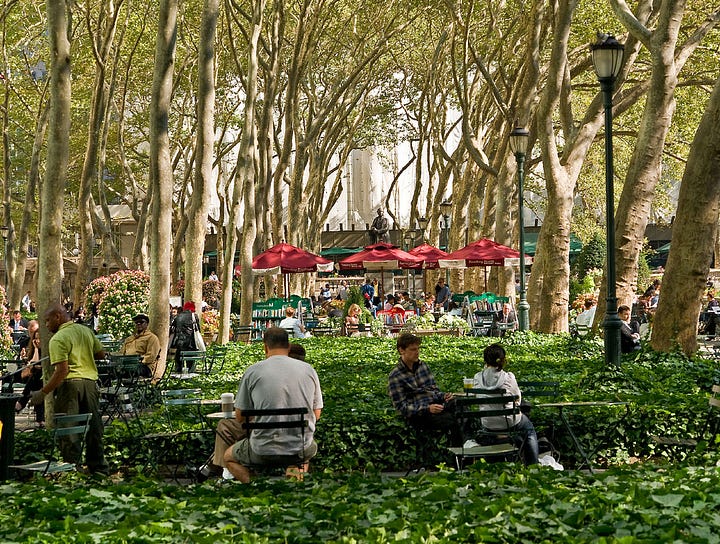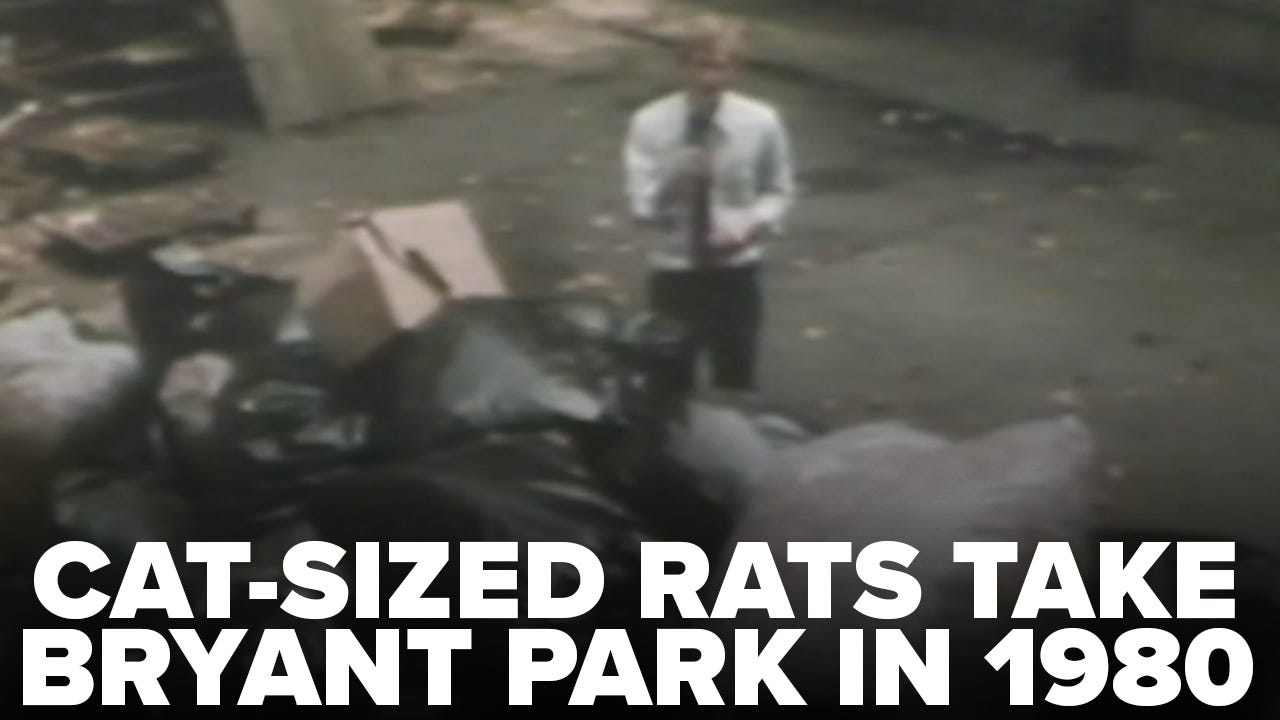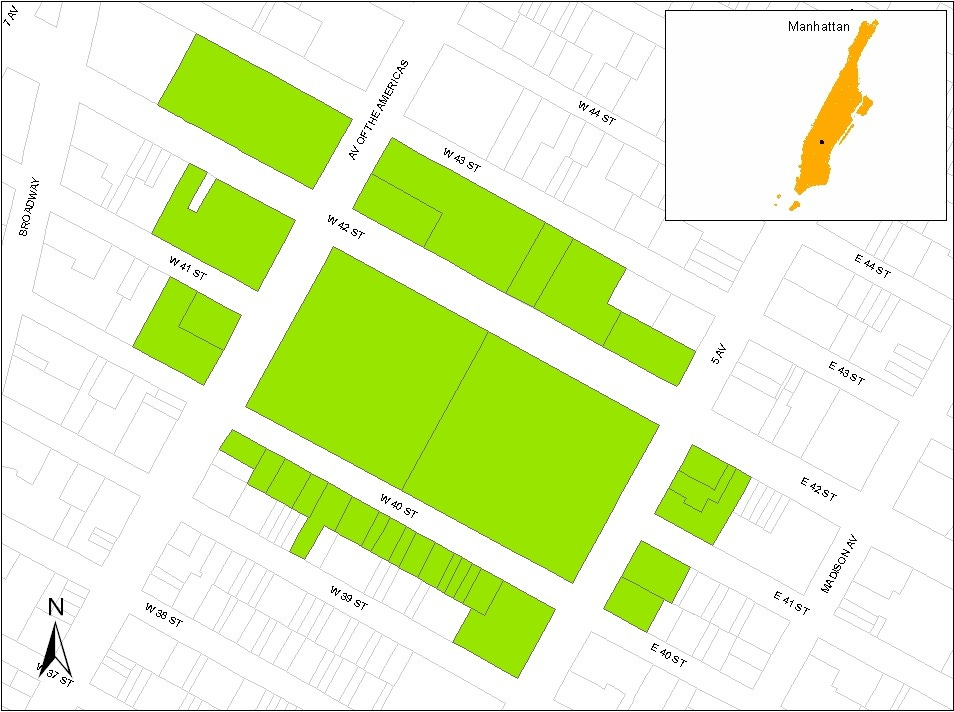The Density Equation: Converting 400x Bistro Chairs to $2bn in Value
Why the right number of chairs matters more than typical "design" decisions in public space design and how 400x bistro seats unlocked more than $2 billion in asset value surrounding Bryant Park.
This post draws from an interview conducted by Range NYC on April 4 with Jerome Barth, the founder of Town Square (an urban placemaking consultancy based in New York City).
(Chul-Hyun Ahn Centennial Park, 2023)1
Most of us rarely consider public spaces as products of deliberate design, unlike a pair of Nike sneakers, where we expect thoughtful and intentional product development. Yet this perception couldn't be further from the truth. The public realm that shapes our daily lives and lived experiences benefits from equally intentional design principles and dedicated professionals who shape, often invisibly. Jerome Barth exemplifies this behind-the-scenes expertise, crafting the urban parks, streetscapes, and public amenities we use daily without recognizing their careful design. The following insights are drawn entirely from an interview with Jerome about his work with the Bryant Park Corporation, demonstrating how purposeful public space design profoundly enhances our urban experience.
Public spaces succeed when operational decisions outweigh architectural ones. Movable chairs provide the flexibility that static design cannot, creating precisely the right density of users—400 people per acre—that transforms empty spaces into vibrant destinations. Programming daily small events, rather than occasional large ones, builds a loyal constituency of regular visitors. The critical ratio of women to men (50:50) is the most reliable metric for measuring perceived safety. European-style commerce integration and "urban rooms" rather than vast open spaces complete the formula for success.
Welcome to Range NYC. If this is your first time here, consider starting with A Note on Content, which outlines the intentions for this publication. You can also read through the About page to learn more.
Range NYC publishes occasional thought pieces about real estate development and construction management in NYC. The posts are long-format and dive into specific issues often covered in series. Topics may relate to policy, technical details of project execution, or deal analyses. Any insights are derived from lived experience.
A Hidden Formula for Billions in Real Estate Value
When Jerome Barth arrived at Bryant Park Corporation in the late 1990s, he encountered a space once synonymous with urban decay and now on a trajectory to becoming the beloved heart of Midtown. Not so long ago, drug dealers operated openly, office workers avoided the area, and surrounding buildings struggled with high vacancy rates and depressed rents. Today, that same park has helped generate over $3 billion in incremental real estate value for the 33 properties behind it.2 This remarkable transformation offers a masterclass in how thoughtful public space management can create extraordinary economic returns.
"We had this idea that just a few years back, Bryant Park was empty, run by criminals, and nobody was going there," Barth explained during our interview. "But there's been this sort of obsession with driving traffic to Bryant Park from the beginning."3 This obsession with traffic—with getting people into the park, and keeping them there—became the north star that guided every decision the Bryant Park Corporation made.
The economic impact of these decisions is remarkable by any standard. Buildings on the park's perimeter now command office rents 12.5% higher than similar buildings just a few blocks away. This premium translates to property values that are 20-25% higher on average, creating approximately $33 million annually in additional tax revenue for New York City.4 For individual buildings, the numbers are equally impressive. The Grace Building on 42nd Street saw asking rents rise by 114% in the decade following the park's reopening, substantially outperforming other competitive submarkets in the area: Times Square (67% increase), Grand Central Terminal (55% increase), and Rockefeller Center (41% increase).5
A $10 per square foot increase in rent at the Grace Building alone translated to $13 million in additional annual rent for the 1.3 million-square-foot building. Using a capitalization rate of 6 percent, this created $216 million in extra value for just one building.6 Multiply this effect across all surrounding properties, and the $3 billion value creation figure becomes entirely plausible.
This value did not emerge from architectural grandeur or expensive materials. It came from a much more fundamental understanding of how humans interact with space.


The Magic Number: 400 Chairs Per Acre
According to Barth, the park's transformation began with anthropological insights rather than architectural ones. The Bryant Park Corporation relied heavily on William H. Whyte's 1979 report, which identified the park's fundamental problems: its isolation from the street, barriers to entry, and lack of visibility.7
"What gives one pause is the enormous differential in costs between many of these projects and the basics that are called for," Barth notes. "The basics are relatively inexpensive."8 These "basics" included removing physical and psychological barriers—removing iron fences, clearing dense shrubbery, and adding inviting steps to establish clear sightlines and easy access from surrounding streets.
But the most fascinating insight emerged around seating density. "If you want 400 people per acre, you need to have 400 seats per acre," Barth explained.9 This seemingly arbitrary number—400 people per acre—represents a natural evolutionary sweet spot for humans to feel that a space is occupied, active, and safe. Get close to this magic density, and the space feels vibrant. But how do you reliably achieve this density?


The Bryant Park Corporation's solution was remarkably straightforward: deploy approximately 3,000 lightweight, mobile bistro chairs throughout the park, not fixed benches, or immovable furniture, but simple chairs that users could reposition as they pleased.
"When people sit down on a chair, almost always they will move it, if only by half an inch," Barth observed. "And there's a powerful gesture of appropriation of a space and saying, this is how I'm making the space mine."10 This seemingly minor detail—allowing visitors to customize their experience through movable seating—created a sense of ownership and comfort that dramatically increased usage.
These decisions ot increase the human interaction with the space weren't guesswork. The Bryant Park Corporation tracked specific metrics, particularly the male-to-female ratio. "People, even if they don't know this theoretically, they know it instinctively—a good space has an even number of men to women. The ratio is 50-50," Barth noted. "Women tend to be much more risk-avoidant. And if a space is bad or presents risks to them or their children, they will seek to avoid it."11
When the proportion of women increased from 29% to approximately 50% following the redesign, it confirmed that the space was perceived as safe.12 Barth explains the psychology: "When you see a space dominated by males, particularly young males, you think you have a little bit of an alarm bell. But if you see a space full of children and women, you're like, this is fine. Nothing bad is going to happen here."13
The park's crime rate fell nearly 100%, transforming a liability into an asset for neighboring buildings.14 This safety dividend directly translated to higher rents and property values as prestigious companies sought park-adjacent space for their offices.
(ABC7 News asset from 1980)
Programming as Infrastructure: The Economic Engine
While most parks focus on physical infrastructure, Barth and his team took a fundamentally different approach. They treated programming—the activities and events happening in the park—as essential infrastructure rather than optional additions.
"The idea of programming was to attract regulars and build a solid foundation for everyday life in the park," Barth explained. "The idea is not to have 6,000-person activities in the park every day, but to have 10, 20-person activities in the park every day."15
These activities needed to be visual and create spectacle—from juggling clubs to language classes to knitting circles. The Bryant Park Corporation developed a sophisticated schedule emphasizing these regular, small-scale events over occasional large gatherings. This approach created a reliable cadence of activities—from morning yoga to lunchtime concerts to evening film screenings—ensuring consistent activation across different times and seasons.
The economic engine behind this programming wasn't massive. The Bryant Park Corporation allocated approximately $150,000 annually for programming, maintenance, and security—a modest investment compared to the billions in value created.16 But the key was consistency. The park operated with a budget six times higher than the previous city management, allowing year-round activation rather than seasonal or occasional use.17
After the initial capital improvement, Bryant Park operated without government operational funding. The Business Improvement District structure allowed for 100% private funding through assessments on surrounding property owners and sponsorships.18 This self-sustaining model ensured consistent quality and accountability to those who had the most to gain from the park's success.
Commerce as Connective Tissue
Another counterintuitive approach that Barth brought to Bryant Park was embracing commerce within the public realm. "There remains a strange, for the European, idea in the usage of public space in North America that commerce and public space should not intersect," Barth observed. "Whereas in Europe, every public space has concessions of all kinds appropriate to the space."19
Bryant Park challenged American norms by building six kiosks, a restaurant, and hosting markets. Barth, bringing his French perspective to American public spaces, explained: "There was this very sort of vision that you needed to provide food and, beyond that, that you needed to provide all types of food. From the snack at the newsstand to the coffee and the pastry to the sandwich, the light summer al fresco meal to the full-scale lunch, dinner, and catered event at the Bryant Park Grill."20
This "hierarchy of food" wasn't just about revenue generation, though the restaurant and kiosks did contribute substantially to the park's self-sustaining financial model. More importantly, these commercial elements served as strategic activation tools that extended dwell time and gave people more reasons to visit. As Barth notes, "It actually supports the local retail. Because it drives people out and they do things, and you can't do everything in the park."20
These commercial elements also provided essential "eyes on the park" throughout operating hours, enhancing security without obvious policing. This approach directly influenced development decisions, as evidenced by Bank of America's decision to build its $2 billion tower at One Bryant Park, completed in 2010. The 2.1 million-square-foot, 1,200-foot-tall tower was deliberately oriented toward the park, which its developer described as "the building's front yard, providing the ultimate amenity for its tenants."21
Similarly, JPMorgan Chase financed the construction of a 470,000-square-foot office tower on Sixth Avenue precisely because of its views of Bryant Park.22 The park had become such an amenity that "Bryant Park" became part of the branding for adjacent properties, further cementing its value-creation role.23
The BID Model: A Value Creation Engine
None of this transformation would have been possible without the Business Improvement District structure that allowed for focused, professional management with dedicated revenue. The 33 surrounding property owners paid assessments based on square footage and frontage, creating a reliable funding stream separate from general city funds.24
(Map of the Bryant Park BID from nyc.gov. The BID was established in 1986 and has an annual assessment of just $2,500,000.00.)25
This structure allowed for professional management with specialized expertise and operating freedom that municipal government typically couldn't provide. Perhaps most importantly, it enabled experimentation and rapid adaptation. As Barth describes, "We were fortunate that the organization was a private organization that could experiment and was willing to take risks. I would argue that most of the things we tried did not work. But many things did work. And like any private organization, you try different things, and then the ones that take hold, you keep improving."26
This experimental approach led to curious insights, such as when they discovered that movable furniture wouldn't stay near the ping pong tables: "No matter what, people would see it, they would walk in, there was a sense of, 'Oh, I don't know if there's going to be another chair on the other side. I'm going to grab it here. "27 After years of frustration, this problem inspired a larger solution: "We then evolved to something that became a big element of a program, which is that there was differentiated furniture in various places in Bryant Park based on activity."28
The BID model critically provided direct accountability to property owners with a vested interest in success, ensuring that all surplus was reinvested into the park and its programming. This virtuous cycle of investment and return helped drive the extraordinary economic results.
From Theory to Practice: Lessons for Developers
The Bryant Park formula offers clear guidance for developers and property owners looking to maximize value through improvements in the public realm. As Barth emphasizes, "The basic plan for improving the park did not come from an architect. It came from the anthropologist I mentioned, William H. Whyte. They gave a physical manifestation to these ideas, but they were not in charge of thinking."29
Relying on a social science rather than a design profession highlights the most crucial insight for developers: "Start with what I will call the program. What's going to happen? And typically, we outsource that to the architect, but most architects are not necessarily very good at that. They're mostly preoccupied with form. But they're not preoccupied with usage and with people."30
For developers seeking to replicate Bryant Park's success, the formula is remarkably straightforward: ensure visibility and easy physical access between public spaces and surrounding streets; incorporate movable elements that allow users to customize their experience; program consistently with small-scale activities rather than occasional major events; integrate appropriate commerce that extends dwell time; and manage intensively with a focus on metrics like gender ratios and usage patterns.
The quantitative results speak for themselves. From a $18 million capital improvement project emerged $3+ billion in real estate value—an extraordinary return on investment in any context.31 But beyond the numbers, Bryant Park offers something equally valuable: a replicable model for transforming public spaces from liabilities into assets through thoughtful management and precise attention to how humans use space.
In an era when developers increasingly compete on amenities, the Bryant Park model demonstrates that sometimes the most valuable investments aren't inside buildings at all—they're in the spaces between them. And sometimes, the key to billions in value creation isn't architectural grandeur but something as simple as placing the correct number of chairs.
Ever upward.
*This Substack is a work in progress that will endeavor to improve over time. If you are reading this, thank you for making it to the end of the post — you are a part of the community that can improve this content. Please comment, share, and send feedback that can improve future posts. What was left out from the above? How could the argument be taken further? Was the post true to Range NYC’s stated objectives in A Note on Content? Send a message with your thoughts.
Through the interplay of mirrors and light, Baltimore-based artist Chul-Hyun Ahn makes mind-bending sculptures that conjure illusions of infinite space. Drawing from op art, light and space traditions, and theories of the subconscious, Ahn explores the immersive, illusory possibilities of reflection. He creates his light boxes by combining one-way mirrors and LED lights; the resulting objects look like portals extending deep into uncharted spaces, defined only by glowing geometric forms and fluorescent fractals. Though Ahn is often described as a light artist, he quickly underlines the significance of space in his work: “At the root, my art is about space,” he says. “Without light, the space was not visible, so I brought light to my artworks so people would experience a sense of deeper space in the direction of the fading light.”
Biederman Redevelopment Ventures, "About," https://www.brvcorp.com/about/
Jerome Barth, interview by Range NYC, April 4, 2025.
Bryant Park Blog, "Bryant Park Raises Property Values and Tax Revenue," March 2015, http://blog.bryantpark.org/2015/03/bryant-park-raises-property-values-and.html
Urban Land Magazine, "The Payoff from Parks," August 29, 2012, https://urbanland.uli.org/economy-markets-trends/the-payoff-from-parks/
Urban Land Magazine, "The Payoff from Parks," August 29, 2012, https://urbanland.uli.org/economy-markets-trends/the-payoff-from-parks/
William H. Whyte, "Revitalization of Bryant Park," November 26, 1979, report to the Rockefeller Brothers Fund.
Jerome Barth, interview by Range NYC, April 4, 2025.
Jerome Barth, interview by Range NYC, April 4, 2025.
Jerome Barth, interview by Range NYC, April 4, 2025.
Jerome Barth, interview by Range NYC, April 4, 2025.
William H. Whyte, "Revitalization of Bryant Park," November 26, 1979. The report noted that female visitors were at about 42% in the early and mid-seventies, falling to 29% by 1979.
Jerome Barth, interview by Range NYC, April 4, 2025.
Dan Biederman corporate biography, https://bryantpark.org/blog/dan-biederman-2
Jerome Barth, interview by Range NYC, April 4, 2025.
William H. Whyte, "Revitalization of Bryant Park," November 26, 1979, approximate figure cited for programming, maintenance, and security.
Dan Biederman corporate biography, https://bryantpark.org/blog/dan-biederman-2
Biederman Redevelopment Ventures, "About," https://www.brvcorp.com/about/
Jerome Barth, interview by Range NYC, April 4, 2025.
Jerome Barth, interview by Range NYC, April 4, 2025.
Jerome Barth, interview by Range NYC, April 4, 2025.
Urban Land Magazine, "The Payoff from Parks," August 29, 2012, https://urbanland.uli.org/economy-markets-trends/the-payoff-from-parks/
Urban Land Magazine, "The Payoff from Parks," August 29, 2012, https://urbanland.uli.org/economy-markets-trends/the-payoff-from-parks/
Bryant Park Blog, "Bryant Park Raises Property Values and Tax Revenue," March 2015, http://blog.bryantpark.org/2015/03/bryant-park-raises-property-values-and.html
https://www.nyc.gov/site/sbs/neighborhoods/bid-directory.page?bid=8
Bryant Park Corporation, "About Us," https://bryantpark.org/about-us
Jerome Barth, interview by Range NYC, April 4, 2025.
Jerome Barth, interview by Range NYC, April 4, 2025.
Jerome Barth, interview by Range NYC, April 4, 2025.
Jerome Barth, interview by Range NYC, April 4, 2025.
Combining capital improvement costs reported by the Bryant Park Corporation with value creation figures from Biederman Redevelopment Ventures.







Very interesting. I wonder under what circumstances it would make ROI sense to tear down a large struggling commercial property and replace it with a park. If the city and surrounding property owners believed they could even come close to Bryant Park's success / value creation, maybe they'd share the cost of demolition, conversion and (crucially, per Barth) management.